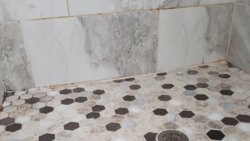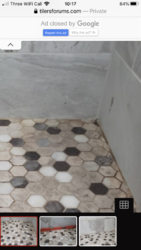Hello,
Bought a new construction home in January 2019 in Orlando. After living in the house for about 6 months, I realized that my master bathroom shower floor was not draining properly. Started seeing discoloration, and mildew around all the areas that were not draining properly. The shower is a "step down" and it has two levels, one drops about 2 inches, the next another 2 inches. I notified my warranty department before my warranty ended, and in seconds, my warranty rep saw the bullnose was stopping water draining from the first step down, and could see discoloration in all corners if the main shower pan. Mildew has been growing fast as well.
The tile company received the request, and without much argument agreed it could and should be fixed (My warranty rep took a picture of the bullnose being too high, and the 24hr+ stagnant water in corners). The solution they provided? Tile over the existing, and fix the slope with a new layer, and that I was responsible for proper cleaning of the mildew ahead of time.
I argued a few items, such as---the mold/mildew problem is likely not only on the "top", but seeps in through the grout and tile as they don't make up a proper waterproof barrier, and that additionally we couldn't tell how much stagnant water is sitting below the tile that didn't drain. There solution, is they will caulk all sides of the shower floor after the new layer is put down. (Which then is something I must maintain, on a newly placed shower pan that cost me extra as an upgrade to this house)
This isn't setting well with me, because to me, this should be ripped up and redone. They failed the first time, they just don't want to invest in the repair. They said that this is acceptable and provided a tile association reference to tile over tile being acceptable.
My warranty guy said that this was the standard practice he has seen, to resolve these kinds of issues--but I seriously think this is not a proper fix.
Any suggestions? Or perhaps my perspective is wrong? Guidance?
Thank you!
Bought a new construction home in January 2019 in Orlando. After living in the house for about 6 months, I realized that my master bathroom shower floor was not draining properly. Started seeing discoloration, and mildew around all the areas that were not draining properly. The shower is a "step down" and it has two levels, one drops about 2 inches, the next another 2 inches. I notified my warranty department before my warranty ended, and in seconds, my warranty rep saw the bullnose was stopping water draining from the first step down, and could see discoloration in all corners if the main shower pan. Mildew has been growing fast as well.
The tile company received the request, and without much argument agreed it could and should be fixed (My warranty rep took a picture of the bullnose being too high, and the 24hr+ stagnant water in corners). The solution they provided? Tile over the existing, and fix the slope with a new layer, and that I was responsible for proper cleaning of the mildew ahead of time.
I argued a few items, such as---the mold/mildew problem is likely not only on the "top", but seeps in through the grout and tile as they don't make up a proper waterproof barrier, and that additionally we couldn't tell how much stagnant water is sitting below the tile that didn't drain. There solution, is they will caulk all sides of the shower floor after the new layer is put down. (Which then is something I must maintain, on a newly placed shower pan that cost me extra as an upgrade to this house)
This isn't setting well with me, because to me, this should be ripped up and redone. They failed the first time, they just don't want to invest in the repair. They said that this is acceptable and provided a tile association reference to tile over tile being acceptable.
My warranty guy said that this was the standard practice he has seen, to resolve these kinds of issues--but I seriously think this is not a proper fix.
I don't know what to do, but I feel this eventually becomes a health concern if the mildew isn't cleaned well (which is my problem) and have no clue what is going on along the grout or under the tile. I just think that the vendor doesn't want to do this properly
Any suggestions? Or perhaps my perspective is wrong? Guidance?
Thank you!







